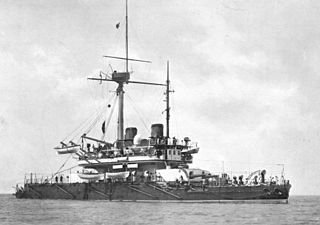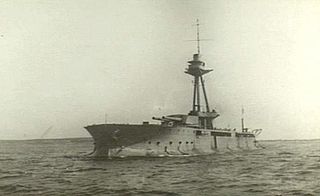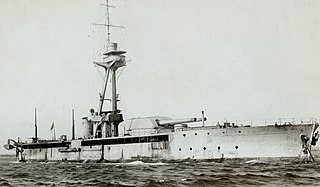
HMS Black Swan, was the name ship of the Black Swan-class sloops of the Royal Navy. This class was admired for its sea-going qualities.

HMS Erebus was a First World War monitor launched on 19 June 1916 and which served in both world wars. She and her sister ship Terror are known as the Erebus class. They were named after the two bomb vessels sent to investigate the Northwest Passage as part of Franklin's lost expedition (1845–1848), in which all 129 members eventually perished.

HMS Raglan was a First World War Royal Navy Abercrombie-class monitor, which was sunk during the Battle of Imbros in January 1918.

HMS Thunderer was one of two Devastation-class ironclad turret ships built for the Royal Navy in the 1870s. She suffered two serious accidents before the decade was out and gained a reputation as an unlucky ship for several years afterward. The ship was assigned to the Mediterranean Fleet in 1878 and was reduced to reserve in 1881 before being recommissioned in 1885. Thunderer returned home in 1887 and was again placed in reserve. She rejoined the Mediterranean Fleet in 1891, but was forced to return to the UK by boiler problems the following year. The ship became a coast guard ship in Wales in 1895 and was again placed in reserve in 1900. Thunderer was taken out of service in 1907 and sold for scrap in 1909.

The Abercrombie class of monitors served in the Royal Navy during the First World War.

The Lord Clive-class monitor, sometimes referred to as the General Wolfe class, were ships designed for shore bombardment and were constructed for the Royal Navy during the First World War.

HMS Charybdis was a Dido-class cruiser built for the Royal Navy during the Second World War and was sunk with heavy loss of life by German torpedo boats in an action in the English Channel in October 1943.

The Marshal Ney class was a class of monitor built for the Royal Navy during the First World War.

The Roberts class of monitors of the Royal Navy consisted of two heavily gunned vessels built during the Second World War. They were the Roberts, completed in 1941, and Abercrombie, completed in 1943.

HMS Abercrombie was a First World War Royal Navy Abercrombie-class monitor.

HMS Albury was a Hunt-class minesweeper of the Aberdare sub-class built for the Royal Navy during World War I. She was not finished in time to participate in the First World War and survived the Second World War to be sold for scrap in 1947.
HMS Prince Eugene was one of eight Lord Clive-class monitors built for the Royal Navy in 1915 to conduct shore bombardments during the First World War. The ship was assigned to the Dover Patrol for the duration of the war and provided cover for the Inshore Squadron during the First Ostend Raid. She was sold for scrap in 1921.

HMS General Wolfe, also known as Wolfe, was a Lord Clive-class monitor which was built in 1915 for shore-bombardment duties in the First World War. Her class of eight ships was armed by four obsolete Majestic-class pre-dreadnoughts which had their 12-inch guns and mounts removed, modified and installed in the newly built monitors. Wolfe spent her entire war service with the Dover Patrol, bombarding the German-occupied Belgian coastline, which had been heavily fortified. In the spring of 1918 she was fitted with an 18-inch (457 mm) gun, with which she made the longest-range firing in the history of the Royal Navy - 36,000-yard (20 mi) - on a target at Snaeskerke, Belgium. After the war, she was laid up before being stripped and put up for sale in 1920. She was finally scrapped in 1923.
HMS Sir John Moore was one of eight Lord Clive-class monitors built for the Royal Navy in 1915 to conduct shore bombardments during the First World War. The ship was assigned to the Dover Patrol for the duration of the war and was sold for scrap in 1921.

HMS Roberts was an Abercrombie-class monitor of the Royal Navy that served in the First World War.

HMS Roberts was a Royal Navy Roberts-class monitor of the Second World War. She was the second monitor to be named after Field Marshal Frederick Roberts, 1st Earl Roberts.

HMS M29 was a Royal Navy M29-class monitor of the First World War. The ship was constructed by Harland & Wolff, in Belfast and launched on 22 May 1915, she was completed in June 1915. During World War I, the monitor served in the Mediterranean Sea at the Battle of Jaffa in 1917 and took part in operations in support of British and White Russian forces in the White Sea during the Russian Civil War in 1919. The ship was then converted to a minelayer and renamed HMS Medusa in 1925. In 1941 Medusa was converted to a repair and depot ship and was renamed HMS Talbot, then renamed HMS Medway II in 1944. In 1946, the vessel was sold for scrap.

HMS M31 was an M29-class monitor of the Royal Navy.

The fifth HMS Valorous, ex-HMS Montrose, was a V-class flotilla leader of the British Royal Navy that saw service in World War I, the Russian Civil War, and World War II.
















